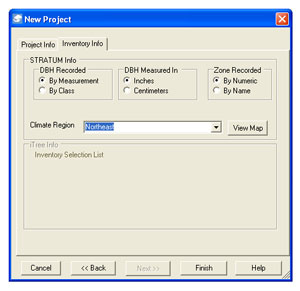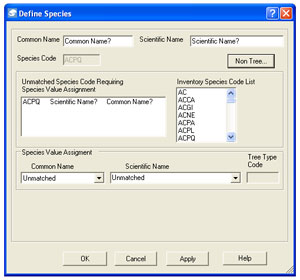Using STRATUM to Analyze the Street Tree Inventory
The following tutorial teaches you how to analyze the data in your inventory with i-Tree STRATUM (Street Tree Management Tool for Urban forest Managers). Note: this tutorial is based on STRATUM version 3.4 (August 2008).
We recommend using STRATUM to:
- analyze the structure and composition of the community forest and
- to quantify the dollar value of annual environmental and aesthetic benefits provided by it.
This tutorial is not intended to provide complete training on how to use STRATUM. Comprehensive instructions can be found in the i-Tree manual pdf that is included in the i-Tree Tools Installation CD-ROM available at no cost upon request from: http://www.itreetools.org/request_cd.shtm
The manual can also be downloaded separately from: http://www.itreetools.org/resource_learning_center/elements/i-Tree_v20_UsersManual.pdf
This tutorial does, however, give an overview on using STRATUM and also addresses some problems which from our experience STRATUM users often run into.
(1) STRATUM requirements
In order for the program to run, STRATUM requires the following:
(a) Inventory data must be contained in a Microsoft Access database file (mdb extension). This mdb file must be compatible with Access 2002-2003 or Access 2000; as of this writing (December 2008) STRATUM will not recognize an Access 2007 accdb file.
(b) The *.mdb inventory file to be analyzed by STRATUM can have any name (e.g. YOUR_COMMUNITY_STRATUM.mdb), but the table containing the inventory itself must be named STRATUM_Inventory. STRATUM will not run if this table has another name and you will receive the error message below:

Larger image
(c) The 17 data fields (e.g. TreeID, Zone, DBH, etc.) within the STRATUM_Inventory table must be named and formatted to the specifications outlined in the STRATUM appendix of the i-Tree manual (August 2008, pgs. 140 to 144). Errors frequently made include incorrect data field types (integer versus text) and incorrect field order. The 17 data fields must be in the order specified below:
1. TreeId – integer
2. Zone – integer or text
3. StreetSeg – integer
4. CityManaged – integer
5. SpCode – text
6. LandUse – integer
7. LocSite – integer
8. DBH – integer
9. MtncRec – integer
10. PriorityTask – integer
11. SwDamg – integer
12. WireConflict – integer
13. CondWood – integer
14. CondLvs – integer
15. OtherOne – integer
16. OtherTwo – integer
17. OtherThree – integer
With respect to text, we suggest using Unicode fixed-length text (versus Unicode variable-length text and ANSI fixed-length or variable-length text) if possible as this type of text seems to encounter fewer problems when running STRATUM.
(d) If your data was collected using the STRATUM/MCTI PDA Utility, it will be in an Access mdb file format. However, if your data is in an Excel spreadsheet or in a GIS shapefile with an underlying dbf table, you will need to reformat and likely recode the data in order to run a STRATUM analysis. Instructions for importing Excel worksheets into Access and formatting the Access file for STRATUM can be found in the STRATUM manual (August 2008, p. 144).
(2) Running STRATUM
Once the program has been opened (the Input and Reports tabs at the top will not be active), it can be run as follows for a new project:
- File > New Project
- A New Project message box will appear – the Project Info tab should be active
- Click on Import and navigate to the location of the Access inventory mdb file
- Under “Inventory Data Type” click on STRATUM Data Format – leave sample inventory unchecked (assuming you are analyzing a complete inventory)
- Click Next at the bottom of the message box – the Inventory Info tab will become active
- Under “Stratum Info” click in the appropriate circles for DBH Recorded, DBH Measured In, and Zone Recorded depending on your data
- Click the arrow to the right of Climate Region and select the zone for your community
Most New York State communities are located in STRATUM’s Northeast Climate Zone. The Adirondack region is located in the North Climate Zone and a small area bordering the St. Lawrence River is in the Midwest Climate Zone. Please consult the i-Tree Manual (August 2008, p. 145) for a map showing these zones.
If, for example, your dbh data has been collected by measurement and in inches, the data in the zone field has been recorded as an integer, and your community is located in the Northeast climate zone, your message box should look like the image below:

Larger image
- Click on Finish at the bottom of the message box
If your data is properly formatted, STRATUM will be ready to run and you will be returned to a screen with STRATUM – New Project at the top with the Input and Reports tabs now active.
If, however, there are errors in the formatting, database, etc. you will receive an error message. One error message frequently encountered is “Unmatched Species Code” (see image below).

To resolve this error:
- Click on OK – a Define Species message box will appear (see image below)

Larger image
In this example, a Norway Maple in the database has been coded incorrectly as ACPQ instead of ACPL. To correct for this error and continue running the program:
- Click on either the arrow below Common Name or the arrow below Scientific Name and scroll through the list to find either Norway Maple or Acer Platanoides (ACPL)
- Click on Norway Maple or Acer Platanoides (ACPL)
- Click on OK in the Invalid Name message box
- Click on OK at the bottom of the Define Species message box
STRATUM is now ready to run and ACPQ will be treated as ACPL. This does not, however, correct the error in the database. Depending on the number of unmatched species codes and the source of the error, you may decide to exit STRATUM and make corrections in the database first before rerunning STRATUM.
(3) STRATUM reports
Generating reports in STRATUM via the Reports tab is quite simple. For example, to generate a report for the Annual Benefits for all trees in the inventory:
- Reports > Benefit-Cost Analysis > Annual Benefits
By default, the initial report will be for Annual Energy Benefits of Public Trees by Species. Report generation can be modified (1) by clicking between Species and Zone in the left corner of the screen (2) the Benefits window on the left side of the screen, and (3) the Public, Private, and All tabs above the report.
To analyze community forest structure such as Species Distribution, DBH Distribution (called “Relative Age Distribution” in STRATUM), and Importance values:
- Reports > Resource Structural Analysis
To report the Replacement Values for all trees in the inventory:
- Reports > Replacement Value
Prior to generating reports, you will probably wish to set certain report parameters via the Input tab. For example, to insert the name of your community in the title of a STRATUM report and to calculate Net Benefits (benefits less costs):
- Input > Define City and Costs
To customize data fields such as DBH Classes which are different than the STRATUM default classes:
- Input > Define Inventory > Data Fields
To make changes to the database from within STRATUM itself:
- Input > Define Inventory > Records
To report trees by scientific (botanic) name rather than by common name:
- Tools > Options > View by Scientific Name
Note: STRATUM will calculate benefits with a minimum of species and dbh data for each tree in the inventory. The more data fields populated with data, the more robust the analysis.
Back to Conducting a Street Tree Inventory
© Copyright, Horticulture Section, School of Integrative Plant Science, Cornell University.